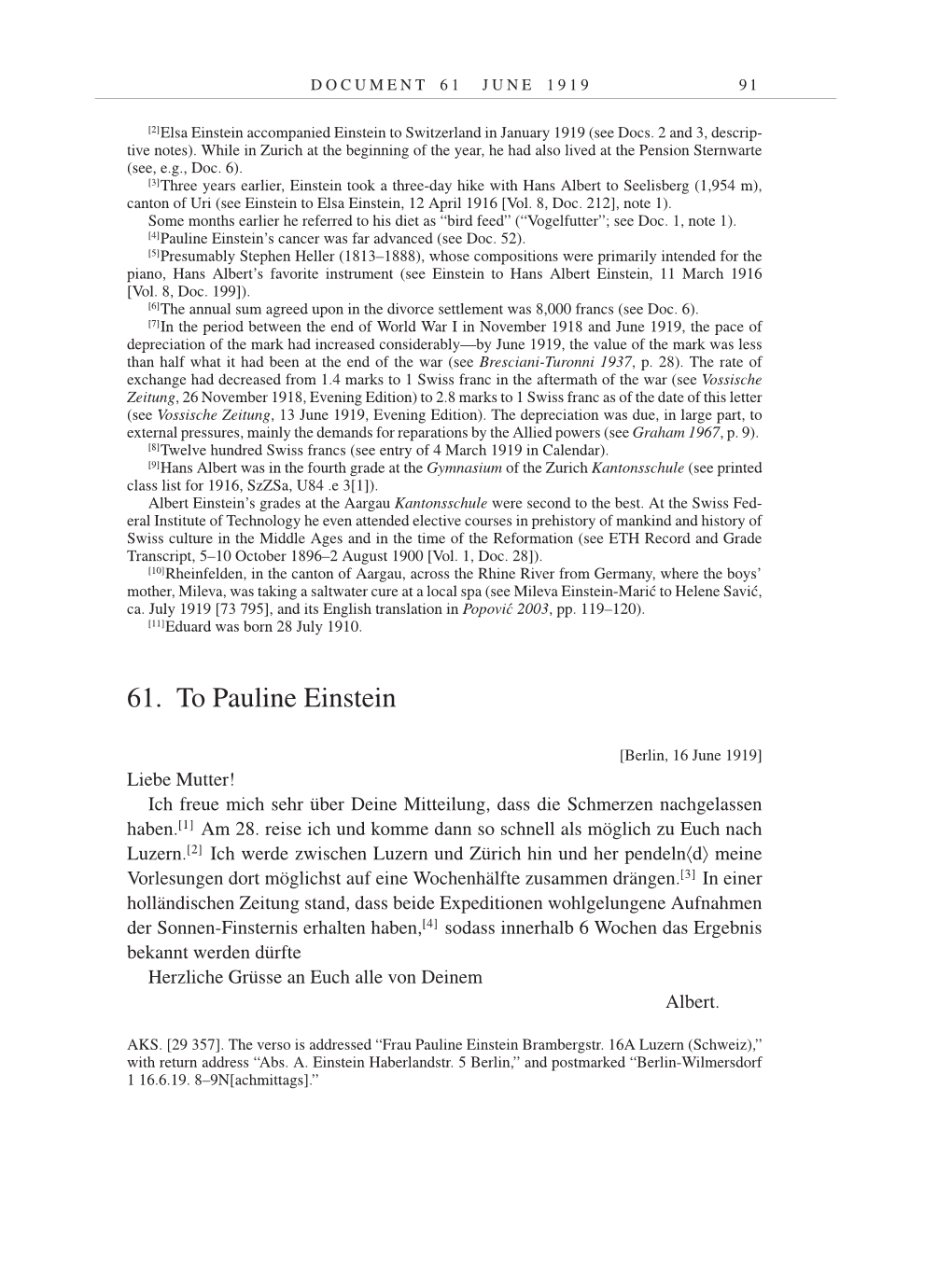D O C U M E N T 6 1 J U N E 1 9 1 9 9 1
[2]Elsa Einstein accompanied Einstein to Switzerland in January 1919 (see Docs. 2 and 3, descrip-
tive notes). While in Zurich at the beginning of the year, he had also lived at the Pension Sternwarte
(see, e.g., Doc. 6).
[3]Three years earlier, Einstein took a three-day hike with Hans Albert to Seelisberg (1,954 m),
canton of Uri (see Einstein to Elsa Einstein, 12 April 1916 [Vol. 8, Doc. 212], note 1).
Some months earlier he referred to his diet as “bird feed” (“Vogelfutter”; see Doc. 1, note 1).
[4]Pauline Einstein’s cancer was far advanced (see Doc. 52).
[5]Presumably Stephen Heller (1813–1888), whose compositions were primarily intended for the
piano, Hans Albert’s favorite instrument (see Einstein to Hans Albert Einstein, 11 March 1916
[Vol. 8, Doc. 199]).
[6]The annual sum agreed upon in the divorce settlement was 8,000 francs (see Doc. 6).
[7]In the period between the end of World War I in November 1918 and June 1919, the pace of
depreciation of the mark had increased considerably—by June 1919, the value of the mark was less
than half what it had been at the end of the war (see Bresciani-Turonni 1937, p. 28). The rate of
exchange had decreased from 1.4 marks to 1 Swiss franc in the aftermath of the war (see Vossische
Zeitung, 26 November 1918, Evening Edition) to 2.8 marks to 1 Swiss franc as of the date of this letter
(see Vossische Zeitung, 13 June 1919, Evening Edition). The depreciation was due, in large part, to
external pressures, mainly the demands for reparations by the Allied powers (see Graham 1967, p. 9).
[8]Twelve hundred Swiss francs (see entry of 4 March 1919 in Calendar).
[9]Hans Albert was in the fourth grade at the Gymnasium of the Zurich Kantonsschule (see printed
class list for 1916, SzZSa, U84 .e 3[1]).
Albert Einstein’s grades at the Aargau Kantonsschule were second to the best. At the Swiss Fed-
eral Institute of Technology he even attended elective courses in prehistory of mankind and history of
Swiss culture in the Middle Ages and in the time of the Reformation (see ETH Record and Grade
Transcript, 5–10 October 1896–2 August 1900 [Vol. 1, Doc. 28]).
[10]Rheinfelden, in the canton of Aargau, across the Rhine River from Germany, where the boys’
mother, Mileva, was taking a saltwater cure at a local spa (see Mileva Einstein-Maric; to Helene Savic;,
ca. July 1919 [73 795], and its English translation in Popovic; 2003, pp. 119–120).
[11]Eduard was born 28 July 1910.
61. To Pauline Einstein
[Berlin, 16 June 1919]
Liebe Mutter!
Ich freue mich sehr über Deine Mitteilung, dass die Schmerzen nachgelassen
haben.[1]
Am 28. reise ich und komme dann so schnell als möglich zu Euch nach
Luzern.[2]
Ich werde zwischen Luzern und Zürich hin und her pendeln〈d〉 meine
Vorlesungen dort möglichst auf eine Wochenhälfte zusammen
drängen.[3]
In einer
holländischen Zeitung stand, dass beide Expeditionen wohlgelungene Aufnahmen
der Sonnen-Finsternis erhalten
haben,[4]
sodass innerhalb 6 Wochen das Ergebnis
bekannt werden dürfte
Herzliche Grüsse an Euch alle von Deinem
Albert.
AKS. [29 357]. The verso is addressed “Frau Pauline Einstein Brambergstr. 16A Luzern (Schweiz),”
with return address “Abs. A. Einstein Haberlandstr. 5 Berlin,” and postmarked “Berlin-Wilmersdorf
1 16.6.19. 8–9N[achmittags].”
